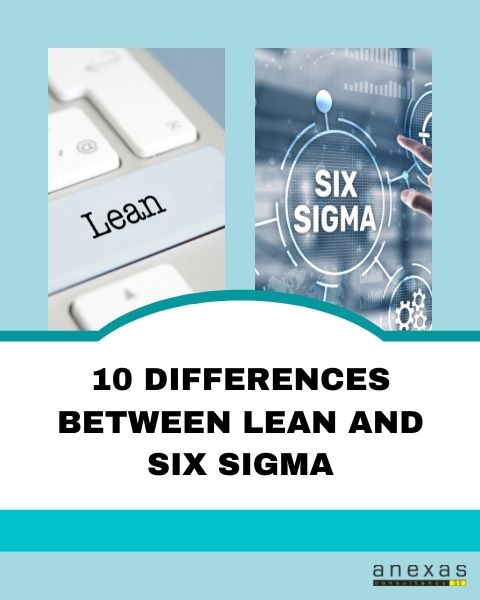Table of Contents
Share This Article
10 Differences between Lean and Six Sigma
- 27916 views
It is commonly asked if there is any difference between Lean and Six Sigma and which is a better approach. There are about 10 differences between Lean and Six Sigma. However, my usual response is that whatever helps your company, that approach is good. Why not learn and try both? This is probably the reason why our certifications are ‘Lean and Six Sigma’ certifications.
Difference between Lean and Six Sigma
In general, many people have difficulty in understanding the difference between Lean and Six Sigma. Both contain tools implemented in business to improve processes or eliminate wasteful steps.
Six Sigma mostly contains tools applied in the improvement of the business process whereas Lean is used in eliminating the wasteful steps in the processes. In this article, you will learn more about the differences between Lean and Six Sigma, and their application in the business processes.

Lean vs Six Sigma
What is the difference between Lean and Six Sigma? Lean is applied in the processes to detect the risks and eliminate the wastes. Six Sigma is used to improve the quality of the process by reducing the variation and the cost involved in the production, making it the major Lean and Six Sigma difference. In short, Lean can be used to reduce cycle times whereas Six Sigma can be used to reduce variation to eliminate defects.
What is Lean?
Lean was first discovered by the Toyota production systems in the 1930s. The term Lean was coined by John Krafcik. Lean is a set of tools and techniques that are used to identify the risks and eliminate waste in the process. The major tools of Lean are Kaizen, 5S, Kanban, value stream mapping, waste identification and flow.
Lean is used in streamlining the business process. It focuses on minimizing waste and maximizing efficiency. Implementation of lean improves the quality of the product and increases the productivity of the company.
What is Six Sigma
To start with the history of Six Sigma, it was pioneered by Motorola. They marked this as a methodology in the year 1991. Six Sigma is focused on improving the quality of the process. Major tools in Six Sigma are hypothesis tests, design of experiments, control charts, regression, correlation, pareto charts and many more.
Six sigma is more statistically driven, specifically to study the ability of the manufacturing process. This tool is almost used in every process to increase the effectiveness of the process. Implementation of six sigma can improve the accuracy and prevent errors.
Six Sigma is combined with the lean tools to bring out the best outcomes. Where Six Sigma methodologies improve the quality of the process, Lean eliminates the errors and reduces cycle times. Together they decrease variation and increase the efficiency of the operations.
10 major problems that occur in an organization
| S.No | Major problems in an organization | This is a Lean problem | This is a Six Sigma Problem |
| 1 | Design services | No | Yes |
| 2 | Quality Management | No | Yes |
| 3 | Supply chain Management | Yes | No |
| 4 | Inventory Management | Yes | No |
| 5 | Strategy Planning | No | Yes |
| 6 | Capacity designing | Yes | No |
| 7 | Layout design | Yes | No |
| 8 | Human Resource management | No | Yes |
| 9 | Sustainability | No | Yes |
| 10 | Transportation | Yes | Yes |
Different characteristics of Lean and Six Sigma
- Most of the processes in the organization are complicated and time consuming. Application of Lean will simplify the process and Six Sigma will improve the quality of the process
- Six Sigma follows methodologies to solve problems. Most commonly used methodology is DMAIC and DMADV. These are used to improve the process.
- DMAIC ( Define, Measure, Analyze, improve, control) are used to refine existing processes, DMADV ( Define, Measure, Analyze, Design, Verify ) are used to create new processes.
- Six Sigma offers different belts of certification. For people who are interested to learn in depth can opt for white, yellow, green, black and master black belt courses.
- Lean focuses on different areas to prevent the error by identifying the root cause of the problem.
- Six sigma focuses on the base streamlining and continuous improvement of process. They are mostly applied in quality management.
- Lean identifies the most common areas that produce waste in the production process.
- Lean can be applied across all industries, be it manufacturing or IT. It analyses the entire process rather than focusing on one step. It can even be applied to the whole supply chain.
- A fundamental principle of Six Sigma is to reduce the variation in the process. As the variation decreases, customer satisfaction increases.
- Lean production analyses the workflow of the organization. Using various tools it reduces the cycle time and cost to achieve high profits.
- When a new process is implemented, Six Sigma makes sure there is continuous improvement in the process to maintain the effective outcome.
10 Differences between Lean and Six Sigma
| Sno. | Characteristic | Lean | Six Sigma |
| 1 | Focus | Reduce waste | Reduce variation |
| 2 | Scope | Suppliers to customers | Organizational processes |
| 3 | Complexity of tools | Low | High |
| 4 | Savings | High | Very high |
| 5 | Ease of implementation | Medium to difficult | Easy to medium |
| 6 | Starts with | Value stream mapping | Define phase |
| 7 | Emphasis | Current process map analysis | Data oriented root cause analysis |
| 8 | Certification Title | Lean Professional | Black Belt |
| 9 | Major Tools | Value stream mapping, wastes, 5S, Poka Yoke, flow | Statistical process control, root cause analysis, hypothesis test, design of experiments |
| 10 | Who can learn easily? | Everyone in the organization | Management |
Difference between Six Sigma and Lean Six Sigma
The key difference between Six Sigma and Lean Six Sigma lies in their scope and approach. Six Sigma is a process improvement methodology that primarily focuses on reducing process variation and defects through statistical analysis and data-driven decision making. On the other hand, Lean Six Sigma combines the principles of Lean and Six Sigma, aiming to eliminate waste and streamline processes while also reducing defects and variation. Six Sigma and Lean Six Sigma differences make them compatible with each other for organizations.
Similarities and Differences between Lean and Six Sigma
Lean and Six Sigma are two distinct process improvement methodologies. Lean focuses on eliminating waste and non-value-added activities to streamline operations, while Six Sigma aims to reduce process variation and defects through statistical analysis. Both approaches share the common goal of achieving operational excellence, and when combined with Lean Six Sigma, they create a powerful framework for improving quality, efficiency, and customer satisfaction. We have discussed the differences between Lean and Six Sigma, now we will discuss the similarities and differences between Lean and Six Sigma.
Similarities between Lean and Six Sigma
Lean and Six Sigma are similar in many ways, there is a similarity between Lean and Six Sigma concepts we can discuss:
- Both reduce the cost, and cycle time and improve customer satisfaction.
- Both increase the profits of the company
- Many tools are standard in process mapping, cause, and effect, Pareto, visual controls, etc
- Both emphasize on project approach towards process improvement
- Both are implemented across the company.
Similarities and Differences between TQM, Six Sigma and Lean
TQM (Total Quality Management), Six Sigma, and Lean are three well-known methodologies in the realm of process improvement. While they share the goal of enhancing organizational performance, they differ in their core principles and areas of focus. The key difference between TQM and Six Sigma is that TQM is a holistic management philosophy focused on overall quality improvement, while Six Sigma is a methodology specifically designed to reduce process variation and defects through statistical analysis.
Similarities between TQM, Six Sigma, and Lean
- Focus on Continuous Improvement: All three methodologies share a common goal of achieving continuous improvement in organizational processes and performance.
- Customer-Centric Approach: TQM, Six Sigma, and Lean emphasize the importance of meeting customer needs and enhancing customer satisfaction.
- Data-Driven Decision-Making: These methodologies rely on the collection and analysis of data to drive decision-making and identify areas for improvement.
Differences between TQM, Six Sigma, and Lean
- Scope and Focus: TQM takes a broad approach, focusing on overall quality management throughout the organization. Six Sigma primarily targets process improvement by reducing defects and variation. Lean concentrates on eliminating waste and optimizing process efficiency.
- Methodology and Tools: TQM encompasses a range of management practices, principles, and tools. Six Sigma employs statistical analysis and specific tools like DMAIC (Define, Measure, Analyze, Improve, Control) for process improvement. Lean utilizes tools such as value stream mapping, 5S, and Kaizen to streamline processes and eliminate waste.
- Implementation Approach: TQM emphasizes the involvement of all employees in the improvement process, creating a culture of quality. Six Sigma typically adopts a project-based approach with designated teams and trained specialists. Lean promotes a continuous improvement culture and encourages employees at all levels to contribute to process optimization.
- Key Metrics: TQM may focus on various quality metrics, including customer satisfaction, defect rates, and overall product/service quality. Six Sigma emphasizes process capability and measures such as DPMO (Defects Per Million Opportunities). Lean often measures cycle time, lead time, and overall process efficiency.
The Lean and Six Sigma difference can be understood by analyzing the different tools used in these methodologies.
Lean and Six sigma are similar in many ways
- Both reduce the cost, cycle time and improve customer satisfaction.
- Both increase the profits of the company
- Many tools are standard in process mapping, cause, and effect, Pareto, visual controls, etc
- Both emphasize on project approach towards process improvement
- Both are implemented across the company.
The difference between Lean and Six Sigma can be understood by analyzing the different tools used in these methodologies.
What is the difference between Lean and Six Sigma tools?
| SNo. | Tools | Lean Tool | Six Sigma Tool | Description |
| 1 | 7 wastes | ✔ | Used to eliminate the common wastes found in process. | |
| 2 | DMAIC | ✔ | Used to improve the existing process. | |
| 3 | 5S | ✔ | A system to organize the work place to perform work effectively. | |
| 4 | Kanban | ✔ | A tool to establish flow in the process by using pull signals. | |
| 5 | Poka Yoke (Error proofing) | ✔ | Tool to avoid or eliminate mistakes. | |
| 6 | Kaizen | ✔ | Tool for continuous process improvement | |
| 7 | Value stream mapping | ✔ | ✔ | Used to understand the system of value streams. |
| 8 | Pareto charts | ✔ | Tool to identify the root cause using 80-20 principle. | |
| 10 | Regression | ✔ | Statistical tool to see relation between two variables. | |
| 11 | Hypothesis Test | ✔ | Statistical validation of root cause with 95% confidence. | |
| 12 | Chi-Square | ✔ | Statistical tool to understand relationships between two attributes. | |
| 13 | ANOVA | ✔ | Statistical tool to understand relationships between a continuous and attribute data. | |
| 14 | Control Charts | ✔ | SPC tool to study the common and special causes. |
What is Lean Six Sigma?
Lean Six Sigma is a combination of both Lean and Six Sigma. So why not take advantage of both? Lean and Six Sigma methodologies such as DMAIC, Kanban, and statistical tools help you analyze every step and identify the steps that can be removed. Similarities between Lean and Six Sigma solve the common problems in any organization and the difference between them make it easy to work on them together.
There is a lot of similarity between Lean and Six Sigma concepts, both tools have their advantages. They cannot be compared to say which is better.
Lean or Six Sigma? What should you use
By now you would have seen the 10 differences between Lean and Six Sigma. Lean Six Sigma would be the best choice. Putting the Lean and Six Sigma tools together can get a much better outcome both effectively and efficiently. Then why use only one! If Lean Six Sigma is implemented, the entire workforce will be benefited with numerous advantages.
Can Lean and Six Sigma coexist?
If you want to find which option is better, there isn’t a definite choice. But you can combine these tools. In spite of the 10 differences between Lean and Six Sigma, Lean and Six Sigma methodologies can coexist. Many companies have started implementing both the concepts and their tools in the organization. The Six Sigma and Lean Six Sigma differences make it better for organizational growth. Lean Six Sigma takes a holistic approach, integrating the waste reduction techniques of Lean with the statistical tools and methodologies of Six Sigma. This combination results in a comprehensive approach to process improvement, encompassing both efficiency and quality enhancements.
Six Sigma improves operation excellence by improving the existing process, whereas Lean production detects the waste in the process. When you apply both together, you can deliver more effective outcomes and increase customer satisfaction by leaps and bounds.
Anexas has implemented Lean and Six Sigma in over 500 companies in the world. These companies range from manufacturing, services, banking, IT, healthcare, logistics, Oil and gas, KPO, BPO, FMCG, telecommunications, transportation, railways, supply chain, etc.
Anexas has completed more than 10,000 projects to date, leading to millions of dollars of savings for the organization. Some of the helpful links where you can get more information on Lean Six Sigma in different industries are given below:
Can TQM, Lean, and Six Sigma coexist?
The main difference between TQM and Six Sigma is that TQM focuses on overall quality improvement, while Six Sigma targets reducing process variation and defects.
TQM, Six Sigma, and Lean share the common goal of continuous improvement, yet differ in their approaches, with TQM emphasizing overall quality management, Six Sigma targeting process improvement and defect reduction, and Lean focusing on waste elimination and process efficiency.
Anexas has implemented Lean and Six Sigma in over 500 companies in the world. These companies range from manufacturing, services, banking, IT, healthcare, logistics, Oil and gas, KPO, BPO, FMCG, telecommunications, transportation, railways, supply chain, etc. Anexas has completed more than 10,000 projects to date, leading to millions of dollars of savings for the organization. Some of the helpful links where you can get more information on Lean Six Sigma in different industries are given below:
Lean and Six Sigma in Anexas
Since 2006 we have trained 150,000 professionals in Lean Six Sigma. More than 10,000 projects that have been completed in various industries have delivered marvelous results. Annexes conducts regular training programs on weekdays and weekends for professionals interested in learning Lean and Six Sigma.
Join us in our upcoming batch and get great offers on all our courses.
All the trainers in Anexas have 20+ years of experience, and I have designed the course based on my 30 years of experience in Quality consulting.
I have rolled out Lean and Six Sigma in many Fortune 100 companies like Maersk, AXA, Deutsche Bank, Bharat Petroleum, ADNOC, Indian railways, Steel Authority of India, KPMG, Deloitte, Novartis, National Healthcare service, John Hopkins, Alfuttaim, King Saud Medical Hospital, Sakra Hospital, International Medical Center, etc. So our training reflects the depth of our knowledge and experience.
Anexas offers excellent deals on all its courses and at the same time ensures that you get the best training in Lean Six Sigma. Anexas provide weekend and weekday training and have a limited batch for a more interactive and valuable session. To join our training, click on the link below.
FAQs
What is required for Lean Six Sigma Green Belt certification?
To take the certification exam, you need to attend the Anexas online training program. It takes around 30 hours of online training and 20 hours of guided study to complete the exam successfully. You can get the certificate by scoring a minimum of 70% in the exam. Certificates by Anexas Europe are recognized worldwide and have lifetime validity. Our trained professionals have a 95% success rate in the exam.
What is required for Lean Six Sigma Black Belt certification?
For this, you need to be a certified Lean Six Sigma Green Belt and then attend Anexas online Black Belt training program. It takes around 35 hours of online training and 25 hours of guided study to complete the exam successfully. You need to score a minimum of 70% on the exam. Certificates by Anexas Europe are recognized worldwide and have lifetime validity. Our trained professionals have a 90% success rate in the exam.
What is required for Master Black Belt certification?
The candidates should have completed Lean Six Sigma Green and Black certifications and have a minimum of 3 years of work experience in their field. To be eligible to apply for Master black certification, you must acquire Anexas Lean Six Sigma Black certification and clear the Master black belt certification exam after attending 30 hours of online classroom training.
Do you require an exam for certification?
Yes, if you want to be a certified professional, an exam is mandatory. Lean Six Sigma offers different levels of certifications based on the difficulty level. You can pursue any level according to your interest.
What is Six Sigma?
Six Sigma is a set of tools and techniques used in many organizations to improve the efficiency of the process. Six Sigma has two major methodologies, namely DMAIC and DMADV. These are implemented for a continuous improvement of the process also the Quality of the process
Do you offer Lean Six Sigma training and certification?
Yes, Anexas offers Lean Six Sigma training and certification. To join our upcoming batch click on the link given below.
What is the difference between Lean and Six Sigma?
Lean production is more focused on waste reduction. It identifies the wasteful process and eliminates them to increase the speed. Six Sigma methodologies are implemented to improve the Quality of the existing or a new process. Six Sigma has different levels of belt certification. Both Lean and Six Sigma are opted by many companies to increase its efficiency.





